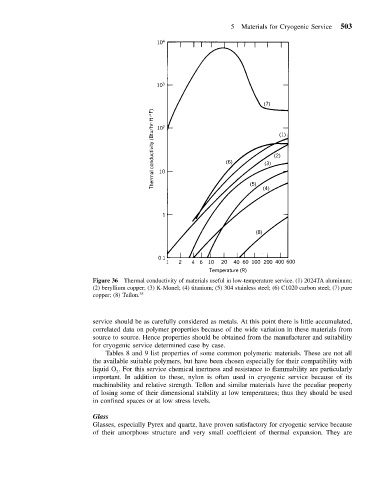Page 514 - Mechanical Engineers' Handbook (Volume 4)
P. 514
5 Materials for Cryogenic Service 503
Figure 36 Thermal conductivity of materials useful in low-temperature service. (1) 2024TA aluminum;
(2) beryllium copper; (3) K-Monel; (4) titanium; (5) 304 stainless steel; (6) C1020 carbon steel; (7) pure
copper; (8) Teflon. 35
service should be as carefully considered as metals. At this point there is little accumulated,
correlated data on polymer properties because of the wide variation in these materials from
source to source. Hence properties should be obtained from the manufacturer and suitability
for cryogenic service determined case by case.
Tables 8 and 9 list properties of some common polymeric materials. These are not all
the available suitable polymers, but have been chosen especially for their compatibility with
liquid O . For this service chemical inertness and resistance to flammability are particularly
2
important. In addition to these, nylon is often used in cryogenic service because of its
machinability and relative strength. Teflon and similar materials have the peculiar property
of losing some of their dimensional stability at low temperatures; thus they should be used
in confined spaces or at low stress levels.
Glass
Glasses, especially Pyrex and quartz, have proven satisfactory for cryogenic service because
of their amorphous structure and very small coefficient of thermal expansion. They are

